The Assumption of the Blessed Virgin Mary falls on 15th August and is one of the oldest and most important Marian feast days in the Liturgical Calendar. This day has been celebrated since the 5th century and commemorates the assumption into heaven of the body and soul of the Mother of God. Even older still is the tradition of blessing medicinal herbs and fruits of the first harvest which was adopted from the pre-Christian folk ways of sacrificing to local land spirits and deities in gratitude for the earth’s abundance. It is also possible that this custom has similarities with the ancient Roman rites performed by devotees of the goddess Diana whose feast day took place on 13th August.
Lady’s Thirty (Frauendreissiger)
In Germany, the beginning of the herb blessing season was known as ‘Lady’s Thirty’ or ‘Women’s Thirty’. Herbs were believed to be endowed with particularly potent attributes during the time period between 15th August and the 15th September, the latter being the ‘Memorial of Our Lady’s Sorrows’. Summer has reached its peak and the meadows and fields are full to the brim with wildflowers and herbs. Following a beautiful Germanic tradition, these flowers and medicinal herbs were gathered, taken to mass on the morning of the 15th August and blessed. After this they were tied into bouquets called ‘Marienwisch’ and hung up to dry.
The earth during this time of Marian devotion and pilgrimage is in her kindest and most generous mood.
Women, particularly herbalists and midwives spent many days in the meadows, woodlands and edges of fields gathering healing plants for the winter ahead. The herbs were thanked during the process of cutting and drying as it was believed that the plants had feelings and were sentient, therefore deserving of respect and gratitude. Some women waited until the end of the thirty days to take their herbs to be blessed allowing them more time to find what they needed.
“Women’s Day with sunshine brings lots of fruit and sweet wine.”
The Assumption of the Blessed Virgin Mary is also known in Germany as the ‘Great Women’s Day (Grosser Frauentag) or Our Lady’s Herb Day (Krautertag) and 8th September which is the Feast of the Birth of the Blessed Virgin Mary is known as ‘Little Women’s Day’ (Kleiner Frauentag).
It was said that no animal or plant could harm you during ‘Lady’s Thirty’. Poisonous snakes could not bite and bees could not sting. Food harvested during this time was especially nutritious and flavoursome and would remain fresh for much longer than at any other time of year.
Legends associating Mary with Herbs
There are many folk legends that associate Mary with the gathering of herbs at this time of year. It is said that the apostles visited Mary's tomb on the third day after her burial and instead of her body all they discovered were roses, lilies and Mary's favourite medicinal herbs. Stories such as this one were instrumental to Mary becoming the patroness of the earth and its vegetation; the next incarnation of the Earth Mother. Everything that bloomed and bore fruit at this time was believed to be blessed by her.
Blessing of the Herbs
The herbs were taken to church in large baskets decorated with roses and ribbons. Fruit, vegetables, cheese, butter and grains were also taken to church to be blessed. Some folk preferred to take their herbs to Capucin or Franciscan monks and were prepared to travel long distances to reach a monastery.
After the blessing it was customary for some folk to throw an apple or pear over their shoulder to attract luck for a good harvest. Then it was time to dry and carefully store away the herbs for the winter especially for Christmas Eve. No fruits of the harvest were eaten before the blessing ritual.
The Herb Bouquet
Once gathered and blessed, herb bouquets were made with a specific number of herbs. The sacred number varied depending on the region’s customs and beliefs as well as what herbs grew locally. Each number had its own meaning, for example,
7 herbs represented the 7 days of creation.
9 herbs represented 3 x 3 in relation to the Holy Trinity,
12 herbs represented the number of apostles.
The number of herbs could also be multiples of the above such as,
24 herbs represented 2 x 12 apostles.
72 herbs represented 6 x 12 apostles.
99 herbs represented 3 x 33 again a symbol for the Holy Trinity.
The following traditional Marian herbs that were consecrated included but were not limited to:
Mullein (often tied in the middle of the bouquet)
St John's Wort (gathered at Midsummer)
Chamomile
Sage
Basil
Rosemary
Lovage
Valerian
Centaury
Eyebright
Nasturtium
Mugwort
Yarrow
Lavender
Lemon Balm
Wild Thyme
Wormwood
Marigold
Chicory
Peppermint
Lady’s Mantle
Aaron’s Rod
Milfoil
Masterwort
Vermouth
Arnica
Plantain
Tansy
Aspen
Flax
Cornflowers
Carnations
Hazel twigs with the hazelnuts
Ears of grain
Hemp
Poppy flower heads and sunflowers

The herb bouquets could be put together according to certain needs, for example, a herb bouquet for treating colds and flu. Herbs such as Mullein and St. John's Wort were considered weather herbs and were said to protect against thunderstorms. Mugwort was generally considered to be a magical and protective herb. A Marian rose was sometimes added to the bouquet as well as fruit or vegetables grown by the family.
Folk Beliefs & Rituals
The consecration of medicinal herbs on 15th August bestowed them with another layer of protective and healing properties. The herb bouquets were intended to protect people, animals and property from harm throughout the year. It also stopped the Devil from leading folk astray. The apotropaic properties of the bouquets were also effective against witchcraft and protected cattle from losing their milk.
The herb bouquet was first and foremost a herbal pharmacy for the winter. Herbs were taken out when the need arose and teas, oils or poultices made from them. Herbs were also mixed into the feed of sick livestock and if a person became sick it was customary to hang herb bouquets around their room as well as smoke cleanse the area. Childbirth, a calving cow or a sleepless child were all occasions that called for the blessed bouquet. A broth could be made from the herbs and drunk by folk and animals who were sick.
During a thunderstorm, if a herb bouquet was thrown into the fire then the house would be protected from lightning. Placed under the pillows of newlyweds on their wedding night ensured a long life with many children. A herbal bouquet, in the shape of a cross and laid under the head or feet of the dead gave their soul strength to continue on their final journey. No wheat ears were added to the herbal cross as this would cause crops to fail. The practice of burying a herbal cross with the dead was not done where a child was concerned.
Another use for the herb bouquets was to smoke cleanse the home and farm buildings to ward off ill luck especially during the period of the ‘Rauhnachten’. The ‘Rough Nights’ was an ‘in-between’ time when the doorway to the other world was wide open from Christmas Eve to the Epiphany. Also known as ‘Holy Nights’, herbal smoke was wafted inside the stables to bring good luck and blessings. It was believed that it was easier for spirits to cross the veil and enter the home and farm during this time so protection rituals were essential.
The word ‘Rauhnachten’ comes from the Middle High German ‘ruch’ (with an accent on the letter ‘u’) meaning wild and hairy. It can also mean ‘smell’. This certainly gives a graphic image of what these evil spirits were believed to look like.
Our Lady Of Herbs (Matki Boskiej Zielnej)
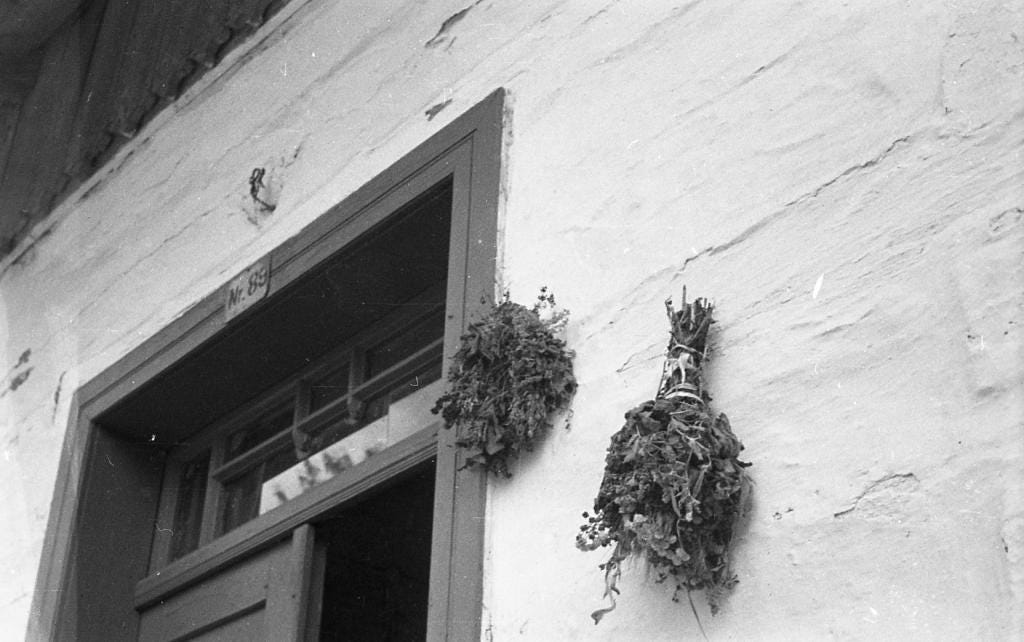
In Poland on the day of Our Lady of the Herbs, the fruits of the earth were blessed in churches with the bouquets resembling traditional Polish Easter Palms. Herbal wreaths were also made and some of them were so large that they had to be transported in carts to get them to the church where the priest could bless them outside. He also blessed rows of tables outside the church covered in the bounties of the harvest. Wreaths were commonly found in southern and eastern Poland whereas bouquets were more traditional in central Poland.
The bouquets had four elements as their foundation.
Herbs
Cereals (wheat, rye, barley and oats)
Fruits
Vegetables, but no potatoes.
Bouquets were tied with a ribbon or a Linden tree slip (a tree cutting). The Linden tree is associated with Mary because it is the tree in which she has appeared the most to folk. Prayers of gratitude were said to Mary and petitions offered up for the following year’s harvest. Those who were able to go on pilgrimages to sacred Marian shrines such as Jasna Gora asked the Madonna for personal blessings. In some villages, farmers joined the processions carrying a statue of Mary through the streets on a bier with her devotees wearing traditional Polish dress.
After bringing the herbs back from church, they were put in the window for a whole day before being strategically placed behind a holy image to ward off evil, to protect against lightning or to attract blessings to the home. Bouquets were hung up in other places too such as next to the wreath that was made at Corpus Christi, next to the family crucifix on the home altar, above the front door, on the front wall of the house, in the attic, on wooden beams or in barn windows. They could also be found in the barn under the first sheaf of wheat and mixed into the animal feed so that the harvest would be plentiful and the animals healthy. They were also left up all year round and only taken down when the herbs were needed for healing. Bouquets were placed amongst the autumn crops to protect them from pests. Only bouquets that had been consecrated could be used to bless the cattle in the spring.
Mary’s herbs reminded folk that she was forever watching over them.
Sweet rolls and bread were baked on this day as well as all through the previous night so that there would be enough for the feast. The harvest feast continued late into the night with praying, folk dancing and the singing of old songs. Doors were left open to welcome anyone who wished to visit. Bonfires were lit in many villages and the previous year’s unused wreaths and bouquets were thrown into the flames and the ashes scattered over the crops for protection. Marian herbs were always ritually burned, not thrown away. Mary was also called Our Lady of the Harvest as the Assumption of the Blessed Virgin Mary was the last day of the harvest according to the agricultural calendar.
The Great Feast of the Mother of God (Golyama Bogoroditsa)
In Bulgaria, mothers refrained from any domestic work on this day apart from baking bread. In the Bulgarian folk calendar, the Assumption of the Blessed Virgin Mary marked the start of the grape, melon and blackberry harvest. These fruits were taken to church to be blessed before being shared amongst family and friends.
Votive offerings were left at holy places and the sick would also spend the night there sleeping in Mary’s healing embrace. Farmers tried their hardest to complete the threshing by this date because it was believed that the straw would turn into wheat. After 15th August the opposite would happen.
“Till Virgin Mary’s Day, straw turns into wheat, and after Virgin Mary’s Day the wheat turns into straw.” - Bulgarian proverb.
Every farm prepared a threshing floor in the yard which was traditionally round in shape as this was believed to protect the farm from evil forces. In the middle of the threshing floor was a pillar to which horses were tied during the threshing of the wheat. A young woman would sit in the cart that brought the wheat back from the fields and the oxen pulling the cart would be fed fertility herbs by the farmer. His wife threw a bucket of water in front of the cart so that the wheat could flow like water on the ground and on the bucket was tied a bunch of sweet basil with a red thread. After this she decorated the oxen’s horns with bread buns baked with the freshly ground flour. In some regions touching the colour red was avoided to protect the cattle from bleeding and young brides from not becoming pregnant. If it rained today then the following year’s harvest would be bountiful.
The Assumption of the Blessed Virgin Mary was widely celebrated with a family ‘kurban’ which was either a ram, ewe or lamb, ritually fed and cleansed before being roasted on an open fire (the liver was boiled and blessed by the local priest). If someone was poorly their forehead was smeared with the blood of the ‘kurban’. Neighbours shared a variety of meats with one another and a traditional pie called a Banitsa was enjoyed as well. The whole feast including the pie ensured a long and healthy life.
Folk travelled in carts full of food to monasteries and churches dedicated to the Virgin Mary and spent the day there feasting and dancing.
Being the Mother of God, Bulgarians saw Mary as the protector of pregnant women and young mothers and as such took offerings of towels, aprons and shirts to church. These were hung from the altar rails or left next to statues.
Malka Bogoroditsa, the ‘Small Feast of the Mother of God’ took place on 8th September to celebrate the birth of Mary. Again it was primarily mothers who participated in this day by resting from work, baking, distributing bread and taking offerings to churches and monasteries. This was also a popular time for a kurban.
The word ‘kurban’ refers to the animal sacrifice offered to God, a saint or a spirit protector of the family or village. It has always been a very important part of family and religious ceremonies in Bulgaria; believed to provide protection and ward off bad luck. ‘Kurban Chorba’ is a traditional Bulgarian soup typically made with mutton, water, tomatoes, parsley, onions, carrots and celery. It is also an important part of religious feasts. The ceremony and soup are often blessed by the local priest and shared with family, friends and the wider community.
Similar customs to these were not only practiced in Germany (the Rhineland, Bavaria and Swabia) Poland and Bulgaria but also in the Caucasus, the Czech Republic ( The day is known as Our Lady of the Root) Armenia and Estonia. Today, folk are doing their very best to keep these traditions alive.

Marian Feasts in August & September
August 15th - Assumption of the Blessed Virgin Mary into Heaven
August 18th - The Coronation of Our Lady
August 22nd - Feast of the Immaculate Heart of Mary
September 8th - Feast of the Birth of the Blessed Virgin Mary (winter wheat sowing was widely done on this day).
September 12th - The Most Holy Name of Mary
September 15th - The Seven Sorrows of the Blessed Virgin Mary
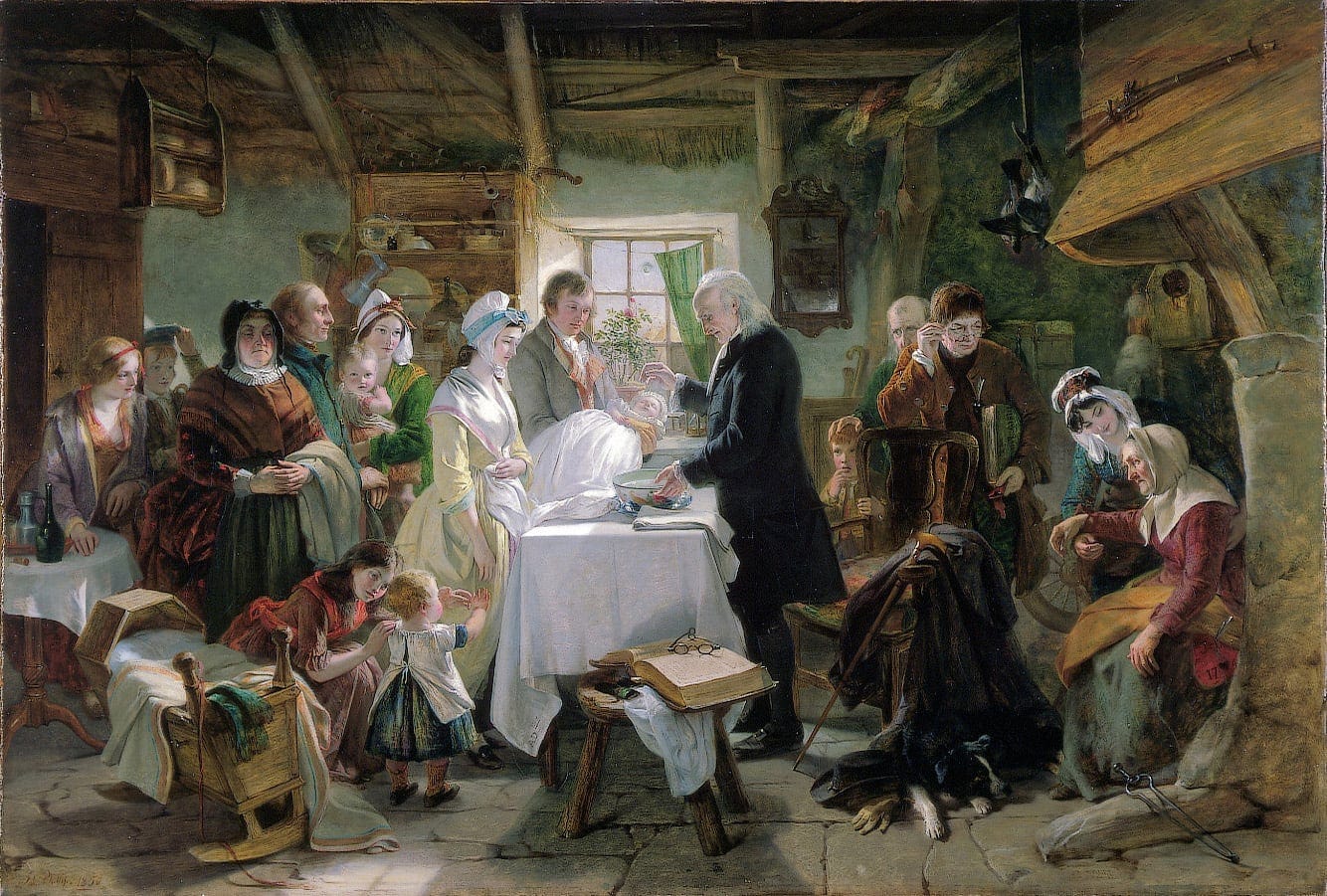
And Lastly
The Assumption of the Blessed Virgin Mary is also known as the ‘Dormition of Mary’ in the Eastern Orthodox Church (Eastern Orthodoxy is predominantly found in eastern and south eastern Europe). The falling asleep of Mary expresses the belief that she died without suffering. The Eastern Orthodox Church has celebrated the Assumption of the Blessed Virgin Mary since the 5th century and the Roman Catholic Church since the feast was instituted by Pope Leo IV in 847 AD. The belief in Mary’s assumption into heaven was made a dogma in the Roman Catholic Church in 1950 by Pope Pius XII despite the death and ascension of Mary not being mentioned in the New Testament.
I hope you found this as fascinating as I did and please share any resources pertaining to Germanic or Slavic traditions in the comment section below as I have only just started exploring this side of my heritage. Because this took me a very long time to research and write I will be covering Celtic celebrations of the Assumption of the Blessed Virgin Mary another time. As for the rest of Britain there are no surviving customs or rituals associated with the Assumption of the Blessed Virgin Mary due to the feast being erased from the English calendar in 1549. Prior to the English Reformation, the Assumption of the Blessed Virgin Mary was widely accepted but the rise of Protestantism and the Church of England under King Edward VI meant that Catholic feasts were no longer officially recognised.
Harvest blessings,
Elissa
A Few Slavic & Germanic Book Recommendations
(Some of these you can find for free on archive.org)
A Calendar of German Customs by Richard Thonger (1966)
The Germanic People by Francis Owen (1960)
The Germanic Invasions by Lucien Mussett (1965)
The Narrators of Barbarian History by Walter Goffart (2005)
The Prehistory of Germanic Europe by Herbert Schutz (1983)
Bulgarian Folk Customs by Mercia MacDermott (1998)
Poland’s Living Folk Culture by Parma Press (2004)
All Books by Sophie Hodorowicz
The World of the Ancient Slavs by Zdenek Vana (1983)
Bulgaria: Cradle of the European Civilisation by Plamen Pavlov (2006)
Bulgaria and the Bulgarians by Plamen Pavlov (2013)
Mother Russia by Joanna Hubbs (1988)
Masquerade and Postsocialism by Gerald W. Creed (2011)
The Slavs by Marija Gimbutas (1971)




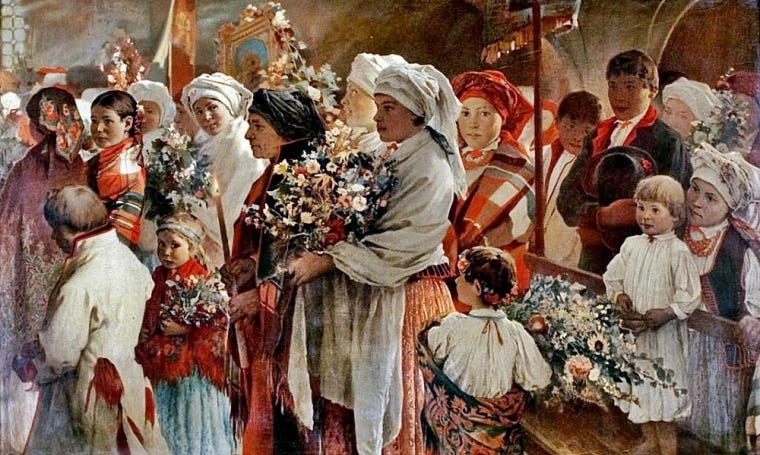

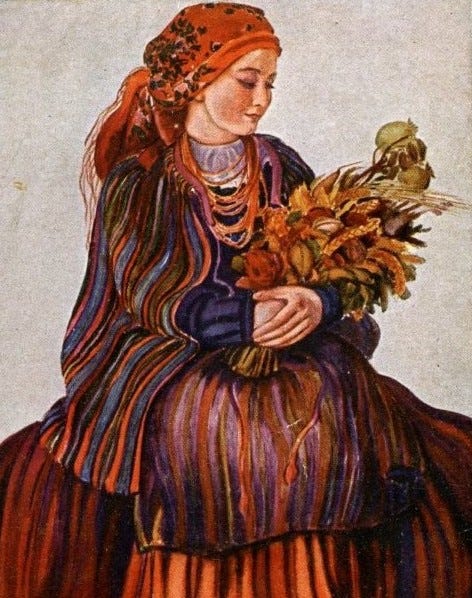
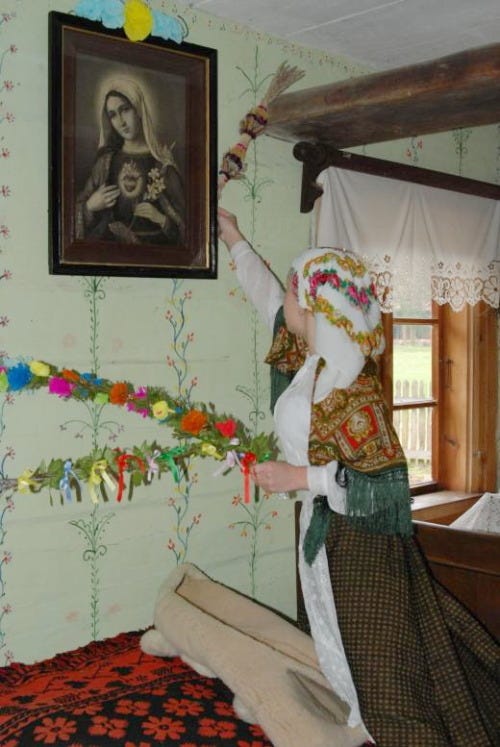
Very interesting and informative read! Thank you ❤️
That was fascinating, thank you for sharing Elissa!!